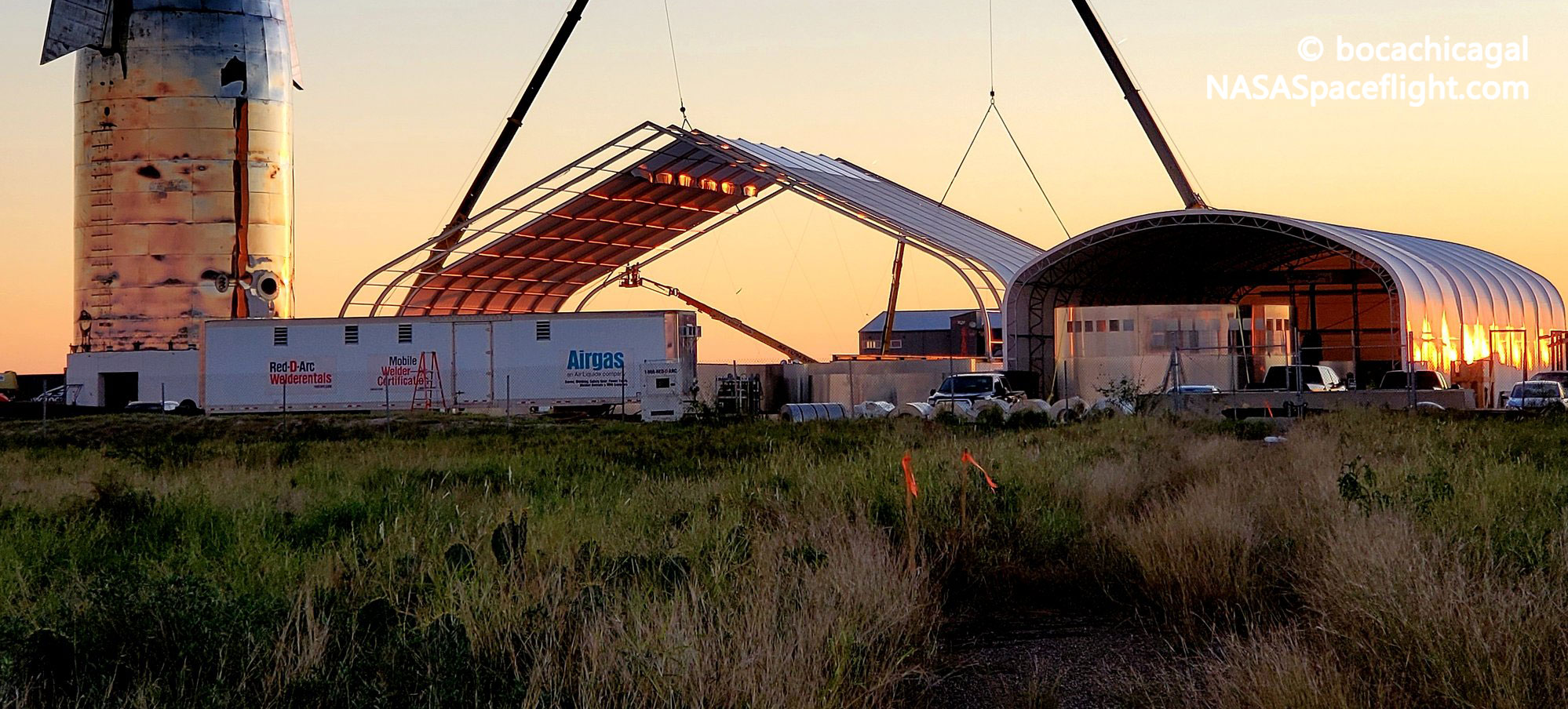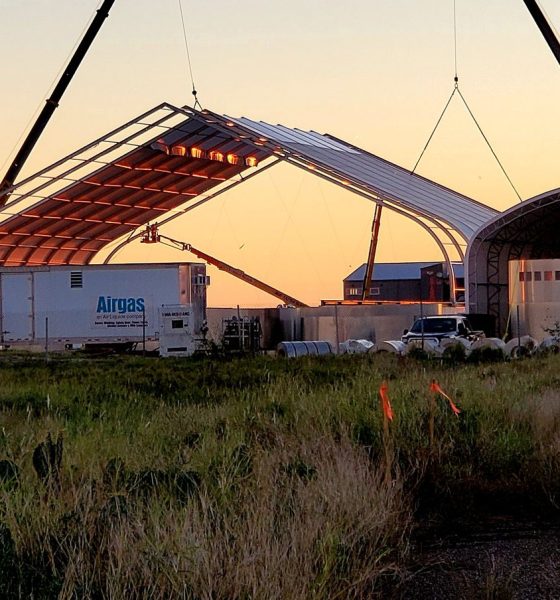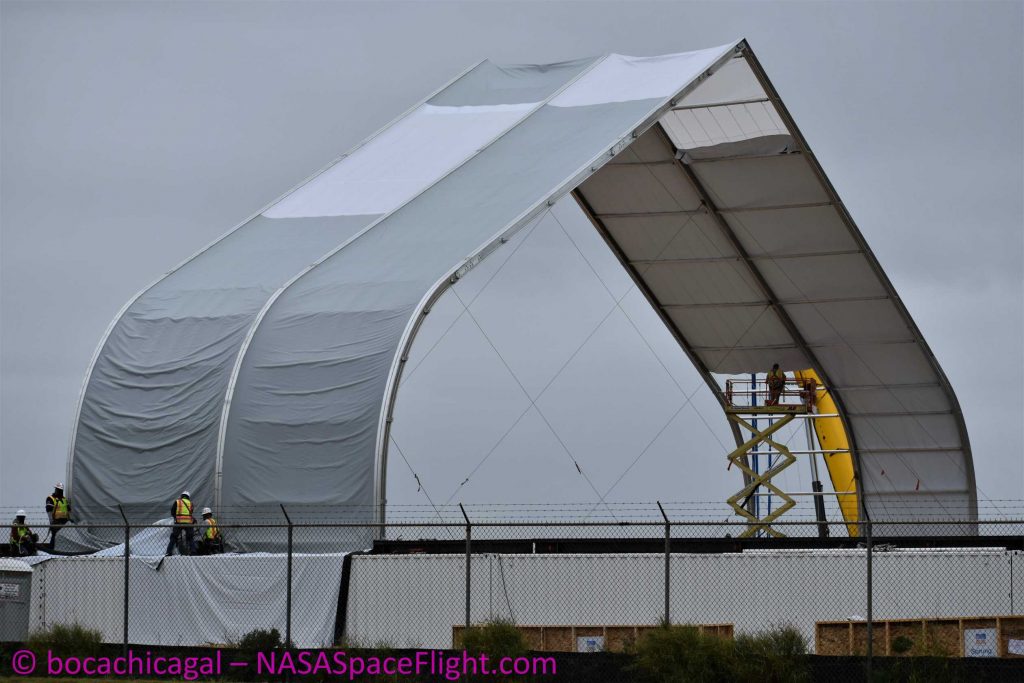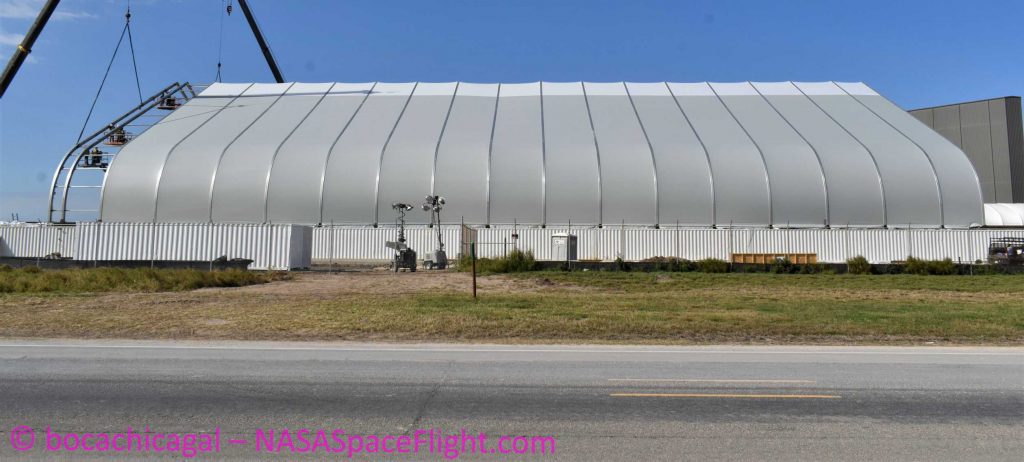

News
SpaceX borrows Tesla's tent factory strategy for new Starship production HQ
Confirmed yesterday morning by CEO Elon Musk, SpaceX has copied Tesla’s approach to factory expansion and is building a giant tent to upgrade its South Texas Starship production facilities.
A big step towards more traditional aerospace-style manufacturing facilities, SpaceX has contracted the same company used by Tesla to create a fourth general assembly line (GA4) in a giant tent outside its Fremont, CA factory in 2018. Instead of Model 3s, however, Sprung Instant Structures (Sprung for short) is rapidly raising a large tent that will eventually allow SpaceX to fabricate and weld more Starship parts and sections in an enclosed environment, an improvement from the current practice of building prototypes out in the harsh environment of coastal Texas.
In typical fashion, Musk believes that the new enclosed production facilities – just a collection of shipping crates as of December 18th – could be ready to begin manufacturing Starship parts as early as next month, and the progress Sprung has made makes it unusually hard to fault his optimism.
Likely taken in mid-December, aerial photos taken by pilot and photographer Sam Sun help sketch out a rough view of the prospective Starship factory. SpaceX appears to have almost entirely foregone a concrete foundation for the new tent, instead opting for lines of steel shipping containers that likely add a bit of height at the cost of structural stability.
.@BocaChicaGal covers the work at these sites extensively, but here's a peek over the fence 😉 pic.twitter.com/0eDJp2agqr— Sam Sun (@BirdsNSpace) December 29, 2019
According to figures printed right on one of Sprung Structures’ many shipments of materials, the initial building will measure approximately 45 meters (150 ft) wide, 77 meters (255 ft) long, and 18 meters (60 ft) tall. While Tesla’s GA4 tent is the same width and (mostly) height, it’s an impressive 280 meters (915 ft) long – almost four times bigger than SpaceX’s newest Boca Chica addition.
While the shipping container foundation is definitely a bit of a risk a mile from the Gulf of Mexico, it does mean that SpaceX might actually be able to move the shell of its new Starship factory if the need arises. SpaceX is in the midst of expanding its Boca Chica lots, potentially giving the company a lot more space to grow its enclosed factory down the road. The simplest possible expansion available would basically double the length of the existing structure, making it more like 150-180 meters (500-600 ft) long.


Regardless, even the current 150′ x 255′ enclosure will end up offering more than 38,000 ft² (3500 m²) of factory space once finished. Depending on what its primary purpose is, SpaceX could probably fit 5-8 stacks of 5-6 rings each (10-11m tall) down the center of the tent, with room for maybe 10-24 additional stacks of 2-3+ rings (3.5-5m tall) in the space remaining. The middle line of hypothetical rings could produce the entire barrel section of 1-2 Starships simultaneously, leaving perhaps 3-4 large sections to be welded together out in the elements or at SpaceX’s new wedge-shaped windbreak.
Of course, the facility will likely end up being mixed-use, potentially offering enough space to simultaneous fabricate all subsections of a single Starship prototype before they are assembled elsewhere.
Ultimately, Sprung is now in the process of installing a large quantity of insulation inside the tent’s walls, indicating that SpaceX’s South Texas welding crew may soon be blessed with a climate-controlled work environment. Meanwhile, SpaceX CEO Elon Musk believes that Boca Chica’s new tent could be complete and ready to begin building Starship hardware as soon as January 2020, while he says that the next Starship prototype – now known as Starship SN01 (serial number 01) – could be ready for flight testing just one or two months after that.
Check out Teslarati’s Marketplace! We offer Tesla accessories, including for the Tesla Cybertruck and Tesla Model 3.

Cybertruck
Tesla updates Cybertruck owners about key Powershare feature

Tesla is updating Cybertruck owners on its timeline of a massive feature that has yet to ship: Powershare with Powerwall.
Powershare is a bidirectional charging feature exclusive to Cybertruck, which allows the vehicle’s battery to act as a portable power source for homes, appliances, tools, other EVs, and more. It was announced in late 2023 as part of Tesla’s push into vehicle-to-everything energy sharing, and acting as a giant portable charger is the main advantage, as it can provide backup power during outages.
Cybertruck’s Powershare system supports both vehicle-to-load (V2L) and vehicle-to-home (V2H), making it flexible and well-rounded for a variety of applications.
However, even though the feature was promised with Cybertruck, it has yet to be shipped to vehicles. Tesla communicated with owners through email recently regarding Powershare with Powerwall, which essentially has the pickup act as an extended battery.
Powerwall discharge would be prioritized before tapping into the truck’s larger pack.
However, Tesla is still working on getting the feature out to owners, an email said:
“We’re writing to let you know that the Powershare with Powerwall feature is still in development and is now scheduled for release in mid-2026.
This new release date gives us additional time to design and test this feature, ensuring its ability to communicate and optimize energy sharing between your vehicle and many configurations and generations of Powerwall. We are also using this time to develop additional Powershare features that will help us continue to accelerate the world’s transition to sustainable energy.”
Owners have expressed some real disappointment in Tesla’s continuous delays in releasing the feature, as it was expected to be released by late 2024, but now has been pushed back several times to mid-2026, according to the email.
Foundation Series Cybertruck buyers paid extra, expecting the feature to be rolled out with their vehicle upon pickup.
Cybertruck’s Lead Engineer, Wes Morrill, even commented on the holdup:
As a Cybertruck owner who also has Powerwall, I empathize with the disappointed comments.
To their credit, the team has delivered powershare functionality to Cybertruck customers who otherwise have no backup with development of the powershare gateway. As well as those with solar…
— Wes (@wmorrill3) December 12, 2025
He said that “it turned out to be much harder than anticipated to make powershare work seamlessly with existing Powerwalls through existing wall connectors. Two grid-forming devices need to negotiate who will form and who will follow, depending on the state of charge of each, and they need to do this without a network and through multiple generations of hardware, and test and validate this process through rigorous certifications to ensure grid safety.”
It’s nice to see the transparency, but it is justified for some Cybertruck owners to feel like they’ve been bait-and-switched.
News
Tesla’s northernmost Supercharger in North America opens

Tesla has opened its northernmost Supercharger in Fairbanks, Alaska, with eight V4 stalls located in one of the most frigid cities in the U.S.
Located just 196 miles from the Arctic Circle, Fairbanks’s average temperature for the week was around -12 degrees Fahrenheit. However, there are plenty of Tesla owners in Alaska who have been waiting for more charging options out in public.
There are only 36 total Supercharger stalls in Alaska, despite being the largest state in the U.S.
Eight Superchargers were added to Fairbanks, which will eventually be a 48-stall station. Tesla announced its activation today:
North America’s northernmost Supercharger Fairbanks, AK (8 stalls) opened to public. https://t.co/M4l04DZ6B5 pic.twitter.com/zyL6bDuA93
— Tesla Charging (@TeslaCharging) December 12, 2025
The base price per kWh is $0.43 at the Fairbanks Supercharger. Thanks to its V4 capabilities, it can charge at speeds up to 325 kW.
Despite being the northernmost Supercharger in North America, it is not even in the Top 5 northernmost Superchargers globally, because Alaska is south of Norway. The northernmost Supercharger is in Honningsvåg, Norway. All of the Top 5 are in the Scandanavian country.
Tesla’s Supercharger expansion in 2025 has been impressive, and although it experienced some early-quarter slowdowns due to V3-to-V4 hardware transitions, it has been the company’s strongest year for deployments.
🚨🚨 Tesla Supercharging had a HUGE year, and they deserve to be recognized.
🍔 Opened Tesla Diner, a drive-in movie theater with awesome, Chef-curated cuisine
🔌 Gave access to Superchargers to several EV makers, including Hyundai, Genesis, Mercedes-Benz, Kia, Lucid, Toyota,… pic.twitter.com/yYT2QEbqoW
— TESLARATI (@Teslarati) December 10, 2025
Through the three quarters of 2025, the company has added 7,753 stations and 73,817 stalls across the world, a 16 percent increase in stations and an 18 percent increase in stalls compared to last year.
Tesla is on track to add over 12,000 stalls for the full year, achieving an average of one new stall every hour, an impressive statistic.
Recently, the company wrapped up construction at its Supercharger Oasis in Lost Hills, California, a 168-stall Supercharger that Tesla Solar Panels completely power. It is the largest Supercharger in the world.
News
Tesla shocks with latest Robotaxi testing move
Why Tesla has chosen to use a couple of Model S units must have a reason; the company is calculated in its engineering and data collection efforts, so this is definitely more than “we just felt like giving our drivers a change of scenery.”

Tesla Model S vehicles were spotted performing validation testing with LiDAR rigs in California today, a pretty big switch-up compared to what we are used to seeing on the roads.
Tesla utilizes the Model Y crossover for its Robotaxi fleet. It is adequately sized, the most popular vehicle in its lineup, and is suitable for a wide variety of applications. It provides enough luxury for a single rider, but enough room for several passengers, if needed.
However, the testing has seemingly expanded to one of Tesla’s premium flagship offerings, as the Model S was spotted with the validation equipment that is seen entirely with Model Y vehicles. We have written several articles on Robotaxi testing mules being spotted across the United States, but this is a first:
🚨 Tesla is using Model S vehicles fitted with LiDAR rigs to validate FSD and Robotaxi, differing from the Model Ys that it uses typically
Those Model Y vehicles have been on the East Coast for some time. These Model S cars were spotted in California https://t.co/CN9Bw5Wma8 pic.twitter.com/UE55hx5mdd
— TESLARATI (@Teslarati) December 11, 2025
Why Tesla has chosen to use a couple of Model S units must have a reason; the company is calculated in its engineering and data collection efforts, so this is definitely more than “we just felt like giving our drivers a change of scenery.”
It seems to hint that Tesla could add a premium, more luxury offering to its Robotaxi platform eventually. Think about it: Uber has Uber Black, Lyft has Lyft Black. These vehicles and services are associated with a more premium cost as they combine luxury models with more catered transportation options.
Tesla could be testing the waters here, and it could be thinking of adding the Model S to its fleet of ride-hailing vehicles.
Reluctant to remove the Model S from its production plans completely despite its low volume contributions to the overall mission of transitioning the world to sustainable energy, the flagship sedan has always meant something. CEO Elon Musk referred to it, along with its sibling Model X, as continuing on production lines due to “sentimental reasons.”
However, its purpose might have been expanded to justify keeping it around, and why not? It is a cozy, premium offering, and it would be great for those who want a little more luxury and are willing to pay a few extra dollars.
Of course, none of this is even close to confirmed. However, it is reasonable to speculate that the Model S could be a potential addition to the Robotaxi fleet. It’s capable of all the same things the Model Y is, but with more luxuriousness, and it could be the perfect addition to the futuristic fleet.








